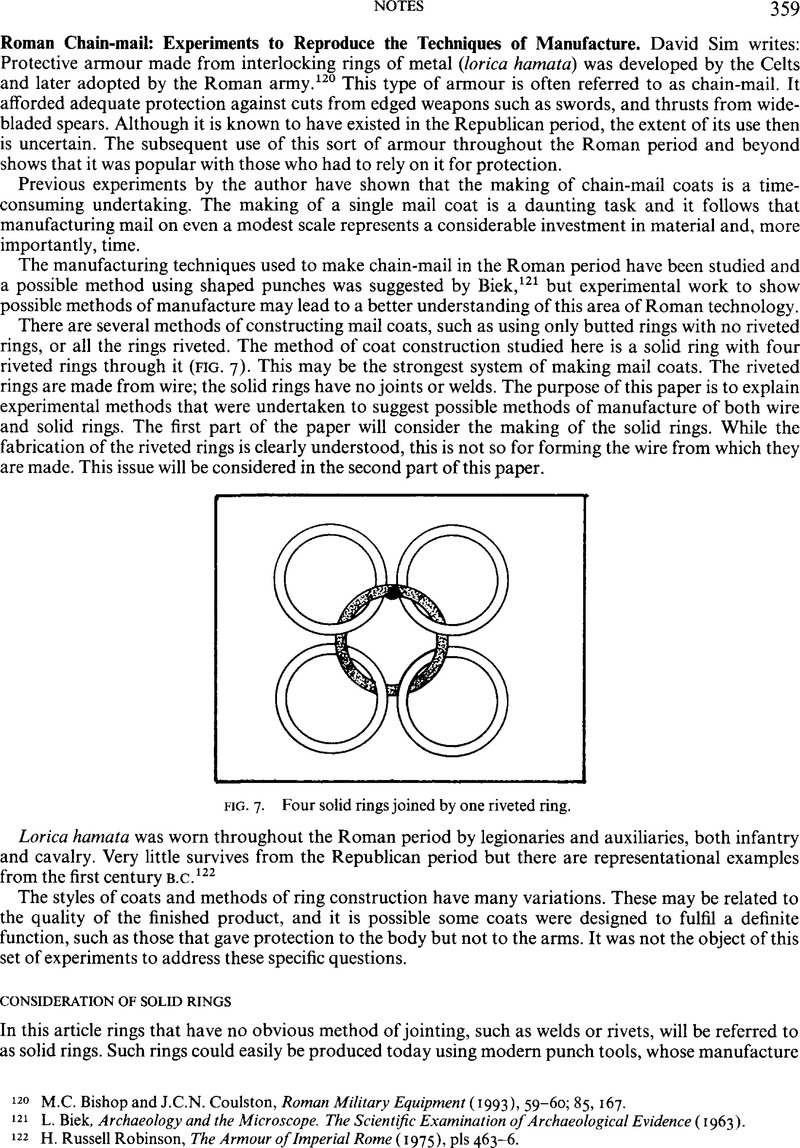Article contents
Roman Chain-mail: Experiments to Reproduce the Techniques of Manufacture
Published online by Cambridge University Press: 09 November 2011
Abstract

- Type
- Notes
- Information
- Copyright
- Copyright © David Sim 1997. Exclusive Licence to Publish: The Society for the Promotion of Roman Studies
References
120 M.C. Bishop and J.C.N. Coulston, Roman Military Equipment (1993), 59-60; 85, 167.
121 L. Biek, Archaeology and the Microscope. The Scientific Examination of Archaeological Evidence (1963).
122 H. Russell Robinson, The Armour of Imperial Rome (1975), pls 463-6.
123 The Grosvenor Museum, Chester, Small finds No s 245, 252, and 257.
124 C. Engelhard, Denmark in the Early Iron Age Illustrated by the Recent Discoveries in the Peat Mosses of Slesvig (1866).
125 K. Raddaz, ‘ReligionsgeschichtlicheProbleme des Thorsberger Moorfundes’, in H. Jankuhn (ed.), Vorgeschichtliche Heiligtümer und Opferplätze in Mittel- undNordeuropa (1968), 190.
126 Russell Robinson, op. cit. (note 122), 164-73.
127 Caerleon chain-mail rings found in via principalis 207 Phase 5B from stores near the tribune's house, second century. Unpublished.
128 Caerleon, see note 127.
129 D.N. Sim and A. Williams, Roman Chain-mail Rings, Production and Metallography (forthcoming).
130 Sim, D.N., Beyond the Bloom; Bloom Refining and Artifact Production in Roman Britain, PhD thesis, University of Reading (1994).Google Scholar
131 Caerleon, see note 127.
132 C. Singer, E.J. Holmyard, and A.R. Hall (eds), A History of Technology (1954), 11, 75.
133 E.G and H.H. Thomsen, ‘Drawing solid wires through soft dies in antiquity’, Transactions of the ASME Journal of Engineering for Industry (1976), 1-5.
134 P. Northover, ‘Late Bronze Age Draw-plates in the Isleham Hoard’, in B. Schmid-Sikimić and P.D. Cassa (eds), Trans Europam: Beiträge zur Bronze- und Eisenzeit zwischen Atlantic und Altai: Festschrift fur Margarita Primas, Antiquitas 3,34 (1995), 15-22.
135 op. cit. (note 133).
136 E.G. and H.H. Thomsen, ‘Early wire drawing through dies’, Transactions of the ASME Journal of Engineering Industry (1974), 1216-21.
137 D. Sim, Experiments to Forge Bloom Iron into Wire (forthcoming).
138 op. cit. (note 136).
139 Found at a depth of 4.3 m, in an area described as ‘a handymans workshop’. It came from Period 3 which is dated between a.d. 97 and a.d. 104.
- 3
- Cited by




